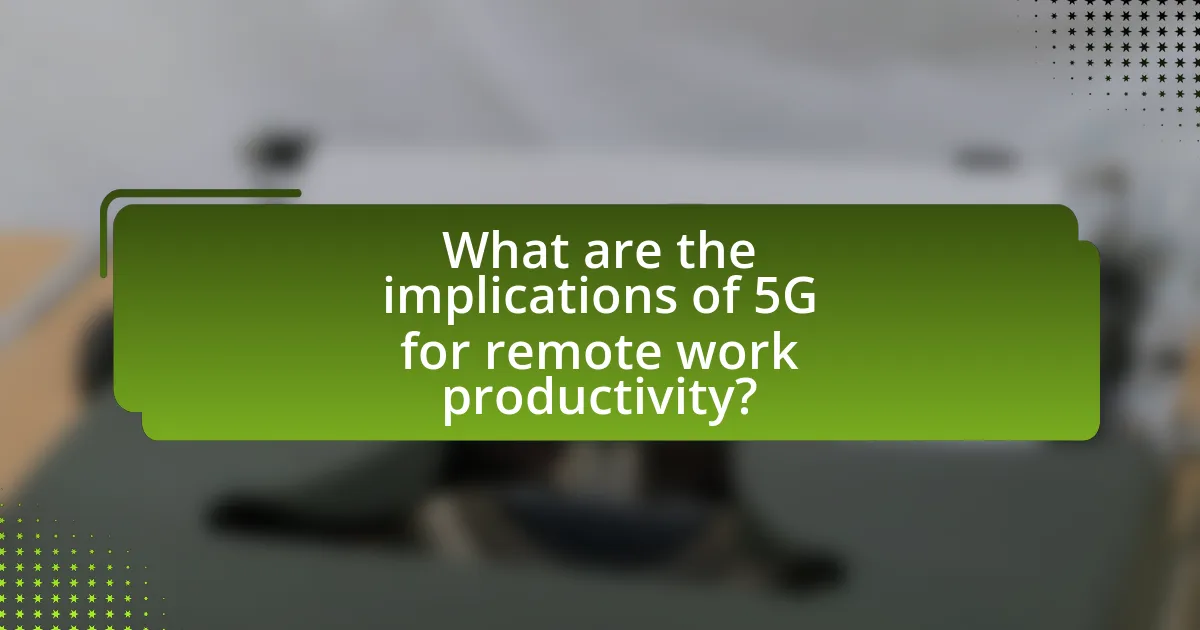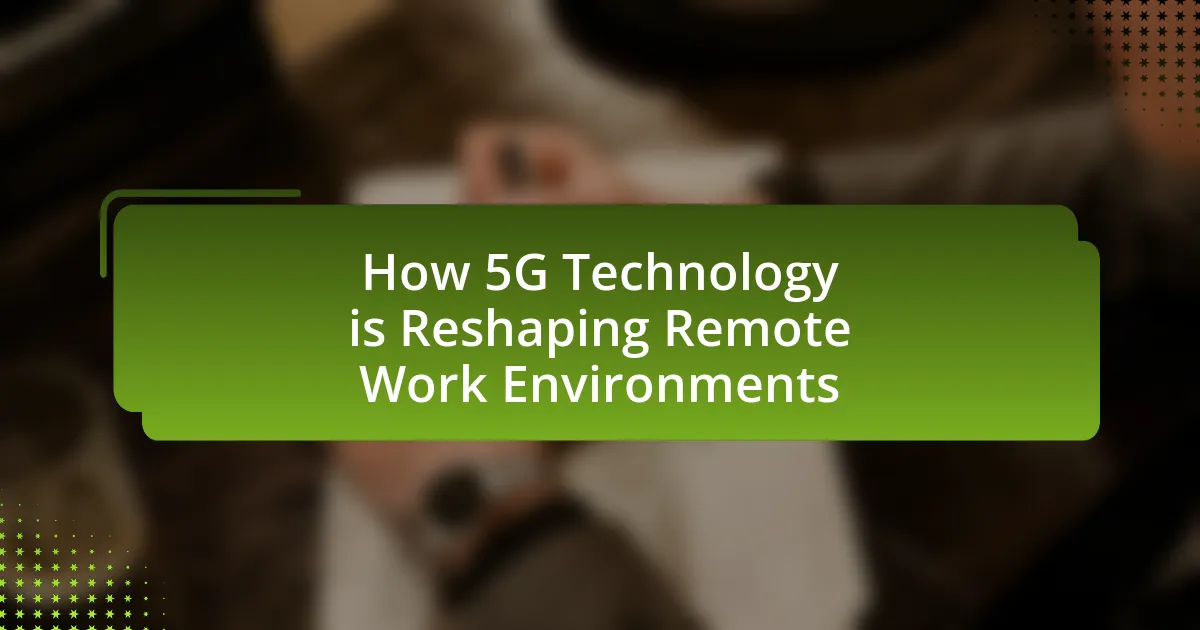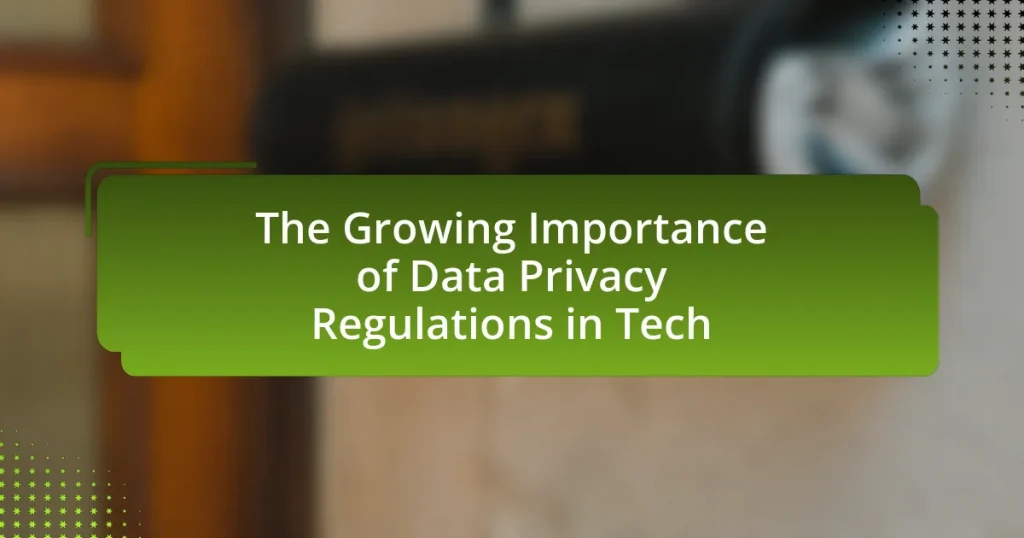5G technology is fundamentally transforming remote work environments by providing faster data speeds, lower latency, and enhanced connectivity. This advancement facilitates seamless video conferencing, real-time collaboration on cloud-based applications, and improved access to remote resources, significantly boosting productivity. Key features of 5G, such as increased bandwidth and reduced latency, address common challenges in remote work settings, making communication and collaboration more efficient. Various industries, including telecommunications, healthcare, and education, are experiencing substantial benefits from 5G adoption, which is crucial for the future of remote work. However, organizations must also consider potential drawbacks, such as increased costs and security vulnerabilities, while implementing effective strategies for a smooth transition to 5G technology.

How is 5G Technology Transforming Remote Work Environments?
5G technology is transforming remote work environments by providing significantly faster data speeds, lower latency, and enhanced connectivity. This advancement enables seamless video conferencing, real-time collaboration on cloud-based applications, and improved access to remote resources, which are critical for productivity. According to a report by Ericsson, 5G can deliver speeds up to 100 times faster than 4G, allowing for high-definition video calls and instant file sharing without interruptions. Additionally, the reduced latency of 5G, which can be as low as 1 millisecond, enhances the responsiveness of applications, making remote work more efficient and effective.
What are the key features of 5G technology that impact remote work?
The key features of 5G technology that impact remote work include enhanced speed, lower latency, increased connectivity, and improved reliability. Enhanced speed allows for faster data transfer, enabling seamless video conferencing and large file uploads, which are essential for remote collaboration. Lower latency, which can be as low as 1 millisecond, reduces delays in communication, making real-time interactions more effective. Increased connectivity supports a higher number of devices simultaneously, accommodating the growing trend of remote work setups with multiple connected devices. Improved reliability ensures consistent internet access, minimizing disruptions during critical work tasks. These features collectively enhance productivity and collaboration for remote workers.
How does increased bandwidth enhance remote work capabilities?
Increased bandwidth enhances remote work capabilities by enabling faster data transfer and reducing latency, which improves the overall efficiency of online collaboration tools. With higher bandwidth, employees can seamlessly participate in video conferences, share large files, and access cloud-based applications without interruptions. For instance, 5G technology can provide download speeds up to 10 Gbps, significantly surpassing previous generations, thus allowing multiple users to engage in high-definition video calls simultaneously without lag. This capability is crucial for businesses that rely on real-time communication and collaboration, ultimately leading to increased productivity and better work outcomes.
What role does low latency play in remote collaboration?
Low latency is crucial in remote collaboration as it ensures real-time communication and interaction among team members. This immediate responsiveness enhances productivity and engagement during virtual meetings, allowing for seamless exchanges of ideas and feedback. Studies indicate that latency below 20 milliseconds significantly improves user experience in video conferencing and collaborative tools, reducing delays that can hinder effective communication. For instance, 5G technology, with its potential to achieve latencies as low as 1 millisecond, directly supports this need, making remote collaboration more efficient and effective.
Why is 5G adoption crucial for the future of remote work?
5G adoption is crucial for the future of remote work because it significantly enhances connectivity, enabling faster data transfer and lower latency. This improved network performance allows remote workers to access cloud applications seamlessly, participate in high-quality video conferencing, and collaborate in real-time without interruptions. According to a report by Ericsson, 5G can deliver speeds up to 100 times faster than 4G, which is essential for handling the increasing demand for bandwidth as more employees work remotely. Additionally, the low latency of 5G, which can be as low as 1 millisecond, supports applications like virtual reality and augmented reality, further enriching remote work experiences.
How does 5G improve connectivity for remote workers?
5G improves connectivity for remote workers by providing significantly higher data speeds, lower latency, and greater network capacity compared to previous generations. This enhanced performance allows remote workers to access cloud applications, participate in high-definition video conferencing, and transfer large files seamlessly, which is crucial for productivity. For instance, 5G can deliver download speeds exceeding 1 Gbps, enabling real-time collaboration without interruptions. Additionally, the reduced latency of around 1 millisecond facilitates instant communication, making remote work more efficient and effective.
What challenges does 5G address in remote work settings?
5G technology addresses several challenges in remote work settings, primarily by enhancing connectivity, reducing latency, and increasing bandwidth. These improvements facilitate seamless video conferencing, real-time collaboration, and efficient data transfer, which are critical for remote teams. For instance, 5G can support up to 1 million devices per square kilometer, significantly improving the capacity for simultaneous connections compared to previous generations. Additionally, the average latency of 5G is around 1 millisecond, compared to 20-30 milliseconds for 4G, enabling near-instantaneous communication and responsiveness in remote work applications. This technological advancement directly addresses issues such as unreliable internet connections and slow data speeds that often hinder productivity in remote work environments.
What industries are most affected by 5G in remote work?
The industries most affected by 5G in remote work include telecommunications, healthcare, education, and manufacturing. Telecommunications benefits from enhanced connectivity and speed, enabling better remote collaboration tools. Healthcare experiences improved telemedicine capabilities, allowing for real-time consultations and remote monitoring. Education leverages 5G for seamless online learning experiences, facilitating interactive and immersive educational environments. Manufacturing utilizes 5G for smart factory applications, enhancing remote monitoring and control of production processes. These industries are significantly transformed by 5G technology, which supports higher data transfer rates and lower latency, essential for effective remote operations.
How does 5G technology benefit the tech industry in remote work?
5G technology significantly benefits the tech industry in remote work by providing faster data speeds, lower latency, and enhanced connectivity. These improvements enable seamless video conferencing, real-time collaboration on cloud-based applications, and efficient access to large data sets, which are essential for remote teams. For instance, 5G can deliver download speeds up to 10 Gbps, compared to 4G’s maximum of 1 Gbps, allowing for quicker file transfers and smoother online interactions. Additionally, the reduced latency of 5G, often below 10 milliseconds, enhances the responsiveness of applications, making remote work more productive and effective.
What impact does 5G have on healthcare remote work solutions?
5G significantly enhances healthcare remote work solutions by providing faster data transmission, lower latency, and improved connectivity. This technology enables real-time telemedicine consultations, allowing healthcare professionals to diagnose and treat patients remotely with minimal delay. For instance, 5G can support high-definition video conferencing and the transfer of large medical files, which is crucial for effective remote patient monitoring and collaboration among healthcare teams. According to a report by the International Telecommunication Union, 5G networks can achieve speeds up to 100 times faster than 4G, facilitating seamless communication and data exchange in healthcare settings.

What are the implications of 5G for remote work productivity?
5G technology significantly enhances remote work productivity by providing faster data speeds, lower latency, and improved connectivity. These advancements enable seamless video conferencing, real-time collaboration on cloud-based applications, and efficient data transfer, which are crucial for remote teams. For instance, 5G can deliver download speeds up to 10 Gbps, compared to 4G’s maximum of 1 Gbps, allowing for quicker access to large files and applications. Additionally, the reduced latency of 5G, often below 10 milliseconds, minimizes delays in communication, fostering more effective teamwork. This combination of speed and reliability directly contributes to higher productivity levels among remote workers.
How does 5G technology facilitate better communication among remote teams?
5G technology facilitates better communication among remote teams by providing significantly higher data transfer speeds, lower latency, and improved network reliability. These enhancements enable seamless video conferencing, real-time collaboration on cloud-based applications, and instant file sharing, which are essential for effective remote teamwork. For instance, 5G can achieve speeds up to 10 Gbps, compared to 4G’s maximum of 1 Gbps, allowing for high-definition video calls without lag. Additionally, the latency of 5G networks can be as low as 1 millisecond, compared to 30-50 milliseconds for 4G, ensuring that communication feels instantaneous. This combination of speed and reliability directly supports the dynamic needs of remote teams, enhancing productivity and collaboration.
What tools are enhanced by 5G for remote collaboration?
5G technology enhances various tools for remote collaboration, including video conferencing platforms, cloud-based applications, and virtual reality environments. Video conferencing tools like Zoom and Microsoft Teams benefit from 5G’s low latency and high bandwidth, allowing for smoother, high-definition video calls. Cloud-based applications, such as Google Workspace and Microsoft 365, experience improved performance and faster data transfer, facilitating real-time collaboration. Additionally, virtual reality tools used for immersive meetings and training sessions gain enhanced responsiveness and interactivity due to 5G’s capabilities, making remote collaboration more effective and engaging.
How does 5G influence the use of virtual and augmented reality in remote work?
5G significantly enhances the use of virtual and augmented reality in remote work by providing faster data transfer speeds, lower latency, and increased connectivity. This technology allows for seamless real-time interactions in virtual environments, enabling remote workers to collaborate more effectively through immersive experiences. For instance, 5G networks can support high-definition video streaming and complex graphics without lag, which is crucial for applications like virtual meetings and training simulations. According to a report by Ericsson, 5G can achieve speeds up to 100 times faster than 4G, facilitating richer and more interactive virtual and augmented reality applications that were previously impractical in remote work settings.
What are the potential drawbacks of 5G in remote work environments?
The potential drawbacks of 5G in remote work environments include increased costs, limited coverage, and security vulnerabilities. Increased costs arise from the need for new infrastructure and devices that support 5G technology, which can be a financial burden for businesses and individuals. Limited coverage is a significant issue, as 5G networks may not be available in all areas, particularly rural or remote locations, leading to inconsistent connectivity. Security vulnerabilities are also a concern, as the complexity of 5G networks can introduce new risks, making remote work data more susceptible to cyberattacks. These drawbacks highlight the challenges that 5G technology may pose in enhancing remote work environments.
What security concerns arise with the implementation of 5G technology?
The implementation of 5G technology raises significant security concerns, primarily due to its increased connectivity and reliance on a vast network of devices. These concerns include vulnerabilities to cyberattacks, as the expanded attack surface can be exploited by malicious actors. For instance, the 5G architecture allows for more devices to connect simultaneously, which can lead to potential breaches if security protocols are not robust. Additionally, the use of software-defined networking in 5G can introduce risks related to configuration errors and software vulnerabilities. According to a report by the European Union Agency for Cybersecurity (ENISA), the complexity of 5G networks makes them susceptible to various threats, including denial-of-service attacks and data interception.
How can organizations mitigate risks associated with 5G adoption?
Organizations can mitigate risks associated with 5G adoption by implementing robust cybersecurity measures, conducting thorough risk assessments, and ensuring compliance with regulatory standards. Cybersecurity measures, such as encryption and intrusion detection systems, protect sensitive data transmitted over 5G networks, which are more vulnerable to attacks due to their increased connectivity. Conducting risk assessments allows organizations to identify potential vulnerabilities specific to their operations and develop strategies to address them. Compliance with regulatory standards, such as those set by the Federal Communications Commission (FCC) or the European Union’s General Data Protection Regulation (GDPR), ensures that organizations adhere to best practices in data protection and privacy, reducing legal and financial risks.

How can organizations effectively implement 5G technology for remote work?
Organizations can effectively implement 5G technology for remote work by investing in infrastructure that supports high-speed connectivity and ensuring compatibility with existing devices. This includes upgrading routers and network equipment to handle 5G signals, which can provide download speeds up to 10 Gbps, significantly enhancing data transfer rates compared to 4G. Additionally, organizations should provide training for employees on utilizing 5G-enabled applications and tools, as 5G technology can support advanced functionalities such as augmented reality and real-time collaboration tools. According to a report by the GSMA, 5G can reduce latency to as low as 1 millisecond, which is crucial for applications requiring instant feedback, thereby improving overall productivity in remote work settings.
What strategies should companies adopt for a smooth transition to 5G?
Companies should adopt a phased implementation strategy for a smooth transition to 5G. This involves assessing current infrastructure, investing in compatible hardware, and training employees on new technologies. A study by the Global System for Mobile Communications (GSMA) indicates that organizations that conduct thorough readiness assessments and pilot programs experience fewer disruptions during the transition. Additionally, establishing partnerships with telecom providers can facilitate access to resources and expertise, ensuring a more efficient rollout.
How can businesses assess their readiness for 5G integration?
Businesses can assess their readiness for 5G integration by evaluating their current infrastructure, technology capabilities, and workforce skills. This assessment involves analyzing existing network systems to determine compatibility with 5G technology, identifying necessary upgrades, and ensuring that devices and applications can leverage the enhanced speed and connectivity that 5G offers. Additionally, businesses should conduct a skills gap analysis to ensure employees are trained to utilize new technologies effectively. According to a report by the GSMA, 5G is expected to contribute $2.2 trillion to the global economy by 2030, highlighting the importance of readiness for businesses aiming to remain competitive in a rapidly evolving digital landscape.
What training is necessary for employees to adapt to 5G technology?
Employees need training in network architecture, cybersecurity, and data analytics to adapt to 5G technology. Understanding the fundamentals of 5G network architecture is crucial as it differs significantly from previous generations, impacting connectivity and performance. Cybersecurity training is essential due to the increased number of connected devices and potential vulnerabilities that 5G introduces. Additionally, data analytics training is necessary to leverage the vast amounts of data generated by 5G networks, enabling employees to make informed decisions and optimize remote work processes. These training areas ensure that employees can effectively utilize 5G technology in reshaping remote work environments.
What best practices should organizations follow when utilizing 5G for remote work?
Organizations should prioritize network security, implement robust collaboration tools, and ensure adequate training when utilizing 5G for remote work. Network security is crucial as 5G networks can be more vulnerable to cyber threats; therefore, organizations must deploy advanced encryption and secure access protocols to protect sensitive data. Implementing collaboration tools that leverage 5G’s high-speed capabilities enhances productivity, allowing for seamless video conferencing and real-time file sharing. Additionally, providing training for employees on how to effectively use these tools and understand 5G technology will maximize the benefits of remote work, ensuring that staff can fully leverage the enhanced connectivity and speed that 5G offers.
How can companies optimize their remote work policies with 5G technology?
Companies can optimize their remote work policies with 5G technology by leveraging its high-speed connectivity and low latency to enhance collaboration and productivity. The implementation of 5G allows for seamless video conferencing, real-time data sharing, and improved access to cloud-based applications, which are essential for remote teams. For instance, 5G networks can support multiple high-definition video streams simultaneously, reducing lag and improving communication quality. According to a report by the GSMA, 5G can deliver download speeds up to 10 Gbps, significantly faster than 4G, which enables more efficient workflows and reduces downtime. By integrating 5G into their remote work strategies, companies can create a more agile and responsive work environment that meets the demands of modern business operations.
What tools and resources are essential for maximizing 5G benefits in remote work?
Essential tools and resources for maximizing 5G benefits in remote work include high-speed routers, cloud-based collaboration platforms, and advanced video conferencing software. High-speed routers enable seamless connectivity and faster data transfer, which is crucial for remote work efficiency. Cloud-based collaboration platforms, such as Google Workspace or Microsoft 365, allow teams to work together in real-time, enhancing productivity. Advanced video conferencing software, like Zoom or Microsoft Teams, leverages 5G’s low latency to provide high-quality virtual meetings, improving communication and collaboration among remote workers. These tools collectively enhance the remote work experience by utilizing 5G’s capabilities effectively.



